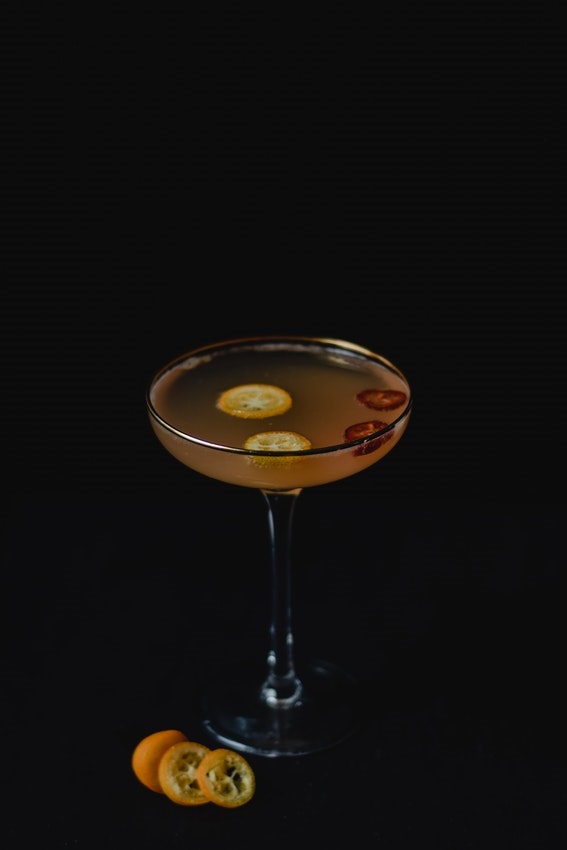Five Iconic Drink Glasses and Their Origin Stories
The Tumbler
In 1896 a New York Times article compared the tumbler’s form to function and said, “so perfect was its balance that it returned instantly to an upright position. Whether turned upon its side or rolled along the floor or dropped upon the soft carpet, the same result followed.” But today’s modern tumbler, absent a metal bottom in most cases, is practical for everyday drinking.
To be clear, its history goes back much further than that 1896 article. In the 17th century, it was one of many simple copper mugs with a pointed or rounded bottom. If you placed it down without emptying the contents, it would “tumble over” and spill your drink. Today’s version works a little differently, and the word itself originates with “tumble,” first noted in English in the early 14th century, from a Germanic word for acrobat.
Nick and Nora
This type of glass may not be as iconic as some on this list, but it may only be a matter of time. The name was only coined in 2005 by the owner of New York’s Pegu Club, and is a throwback to Nick and Nora Charles, a mystery-solving married couple from Dashiell Hammett’s novel The Thin Man and its subsequent TV spinoffs, were known for knocking back cocktails at their fictional house parties in the 1930s. Today, it’s a testament to the enduring allure of custom barware.
The Coupe
Stories for the origins of the coupe glass are a mix of myth, sexual innuendo, and clever marketing: a lovelorn glassblower designed his Champagne glass to honor the last queen of France prior to the French Revolution, using Marie Antoinette’s left breast as the breathless inspiration for his creation. Other historians give it a more prosaic beginning, saying the coupe glass came about in England around 1663, more than a century earlier, for Champagne and sparkling wine.
Regardless, there’s no evidence the champagne glass was modeled after the bosom of soon-to-be-beheaded Marie Antoinette. Who knows, maybe the French queen preferred solid copper mugs for her beverages rather than fine glassware. Such rumors came about in the 20th century and are due to the coupe’s overt sexiness, allure, and European heritage. The coupe turned more than a few heads when it was tipped to the lips of Hollywood starlets like Marilyn Monroe, Sophia Loren, Claudia Schiffer, and many others.
The Martini Glass
Sure, the V-shaped martini cocktail glass has tumbled from grace among modern cocktail aficionados, but its iconic shape remains synonymous with cocktail culture. The cone-shaped bowl-on-a-stem debuted at the 1925 Paris Exhibition as a modernist version of the coupe. But it wasn’t until the end of World War II that the glass gained fame. The name is often used interchangeably with “cocktail glass,” yet both have the same job description.: keeping your martini icy cold.
And, despite what many bartenders tell customers, the martini cocktail glass didn’t originate during Prohibition. Not only that, but the drink preceded the glass by about four decades. As for the martini itself? It was originally served in a custom copper mug, the coupe, or other wine glasses.
The Moscow Mule Mug (aka The Copper Mug)
In 1941, Sophie Berezinski was a woman with a mission. A recent immigrant to the United States from Russia, Sophie was carrying a significant burden: 2,000 solid copper mugs. Her father was the proprietor of a copper factory in Russia named the Moscow Copper Co. Back in Mother Russia, Sophie breathed life into the design for the unique copper mug that’s now famously linked to another fabled creation, the Moscow Mule cocktail – served, of course, in a Moscow Mule mug. Her father’s job? Run the presses that stamped out the mugs.
While striking out in her own marketing efforts, and wary of her husband’s promise to her and her husband out on the street if she didn’t locate a buyer, Sophie hit the streets of Hollywood, walking door to door in desperation to find a bar or lounge owner who’d understand the beauty and utility of the drinking implements crafted back in Russia. During one of her grueling days of searching, fortune favored the foolish and she walked into the famous Cock ‘n’ Bull pub on the Sunset Strip.
Sophie happened upon the Cock ‘n’ Bull pub at the right time, on the right day in 1941 to help birth a cocktail America would fall passionately in love with. John Martin had bought the floundering but famous Smirnoff Vodka distillery years before. Though successful as the head of G.F. Heublein & Brothers, a food and spirits importer with A1 steak sauce in its product showcase, Martin wasn’t as lucky with vodka. He was commiserating at the time with his friend, Cock ‘n’ Bull owner John Morgan who more than understood what Martin was going through. Morgan, too, was having a rough go of it – determined to introduce America to his peculiar brand of ginger beer. And then Sophie walked in.
As Sophie would later recount, the trio spent hours creating a drink that would combine the fizzy nature of ginger beer with the punch of vodka and the inherent coldness of copper to launch the next great cocktail on an unexpecting America. The Moscow Mule’s birth certificate was that day in 1941. It soon became a cocktail that America would cherish for the next century and beyond.
The rest is history.

 Default Currency
Default Currency
